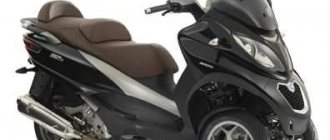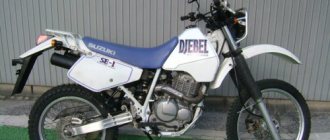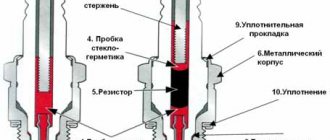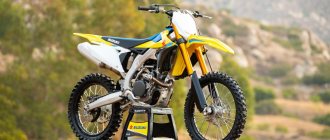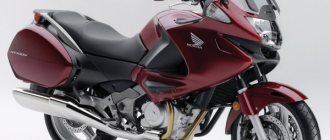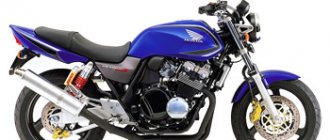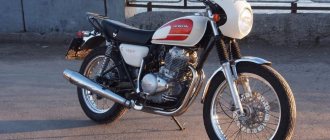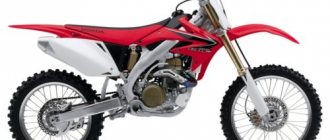Is it possible to stop time? This question cannot be answered unambiguously. On the one hand, we have the inviolable laws of physics that clearly prohibit stopping the passage of time. On the other hand, in addition to all the quantum exoticism that does not prohibit time travel, we have museums that store samples and artifacts of a particular era, and human imagination can immerse us in almost any era. Many people devote themselves to studying and reconstructing past times in order to immerse other people in them. So the question about time travel is more like this: how difficult is it to experience yourself in another time? The answer is individual and depends on imagination, but imagination can already be helped by creating the appropriate environment and atmosphere.
Today I offer you, my dear reader, a small immersion into the atmosphere of days gone by. And let me tell you a little about where we will dive, create the appropriate atmosphere, so to speak.
So, the 70s of the 20th century. A generation of people has matured who only heard about the hysterical wail of an air raid siren and the crackle of machine gun fire from the stories of the older generation. Yes, there are enough tense points in the world, there is a “cold war”, and, as its hottest manifestation, the war in Vietnam. But the generation of the 70s was tired of wars and conflicts, tired of having to survive and not live. This resulted in the 70s becoming a time of “freedom”. The younger generation decided to go beyond the boundaries, self-expression became a kind of icon. Many have delved deeper into understanding themselves and their place in this world. Each social, cultural or subcultural group created its own style and way of life, and, like icing on the cake, the firm tread of the sexual revolution, heavily implicated in the availability of psychotropic substances. And this was in almost everything: in music, in painting, in architecture, in design. Yes, even, damn it, in cooking!
Well, what about motorcycles? Well, motorcycles of the 70s era were also quite diverse. Cruisers, or motorcycles for tourism, have already begun to acquire panniers and fairings, and choppers have fixed their canonical appearance. However, for the most part, these were the same “classic” devices, outwardly not very far removed from a bicycle without pedals, but with an engine. Sports motorcycles are also a little behind them. Yes, the obvious advantages of aerodynamics perched cockpit-like fairings on the front and forced the pilot to take a rather strange pose, but still, they are far from modern, precise aerodynamic forms. Compared to aviation, these were no longer bulky multiplanes made of wood and fabric with braces on the wings, but the F-117 Night Hawk was still far away.
Civilian versions of sports motorcycles (although here it is impossible to say for sure what was primary and what was built from what - sports motorcycles from civilian ones or, on the contrary, civilian ones created on the basis of racing versions, it will not work, but this does not change the essence) were changed mainly by removing the fairings , and the return of such parts that are not needed in motorsports, such as headlights and turn signals. However, this was a very successful marketing ploy - the client saw an athlete at the races, dashing along the track on a motorcycle almost the same as the one on which he himself arrived. It gave a feeling of belonging. Such motorcycles, which looked like their sports counterparts, began to be called superbikes (SuperBike). And this, in itself, gave birth to a new fashion and a new subculture. The seeds of a superbike fell into the very fertile soil of Cafe Racers, they were a kind of stimulus for development and reborn cafe racers into street fighters. In essence, nothing has changed: the same strong guys in leather jackets, representatives of the “working youth,” so to speak. They, just like in the 50s and 60s, rushed along the roads to show off their brave prowess, entered into conflicts with government officials, and had “tender” relationships with other subcultures. In general, a kind of stereotypically romanticized image of a “bad guy” on a noisy, dirty, but damn fast motorcycle.
And now that, I hope, I have created the necessary atmosphere of creative madness with lysergic ponies to the sounds of disco and the roar of heavy engines, I will still move on to our today’s hero: the Honda CB1100RS - a classic superbike of the 70s, a little more than completely.
Well, here it must be said that all the signs of “that same superbike” are observed exactly. Duplex frame made of steel pipes, cast wheels (in the EX version the wheels are spoked, which is somewhat closer to civilian technology of those years), air-oil-cooled engine, chrome-plated exhaust pipes on both sides of the motorcycle, rounded double saddle, direct fit, round headlight and a simple brake light placed on the wing. A minimum of decorative and other unnecessary details, and a maximum of load-bearing elements on display. It would seem that everything is simple and banal, and, in general, even ordinary, but the devil, as we know, is in the details.
Let's start with the fit and ergonomics. The seat looks quite simple, an ordinary two-seater “sofa”, with only a nominal hint of a “step”, which should mean poor support for the fifth point. But when you sit on this seat, it is pressed down somewhat, and the emphasis becomes very noticeable, which significantly adds to comfort. The legs habitually find the footrests, the hands find the handles themselves, the fingers precisely fall on the levers, all movements and positions are on an intuitive level, classic. In general, the ergonomics suggest some forward lean, making the riding position moderately aggressive, but not so much that it is noticeable. The remote controls on the steering wheel, by the way, are ascetic, one might even say rustic, the range of functions is minimal, but everything is at hand and there is nothing superfluous. You definitely won't get lost in the buttons.
The chassis is also not overly complex: a steel spine made of pipes, a tank on it, a motor under the tank, two wheels, two front seats, two shock absorbers at the rear, disc brakes - that’s, in fact, the whole simple set. But all together it gives amazing maneuverability. Rigid frame, front suspension, although not a newfangled “changeover”, but quite modern, rear shock absorbers of a backpack type, everything is from Showa and most likely corresponds to the 21st century. A minimal, but still sufficient, set of suspension adjustments, tenacious brakes with ABS and excellent feedback, all this together makes the motorcycle quite nimble, even aggressive. It takes turns with great pleasure; it moves along the trajectory like a locomotive on rails, no wobbling, yawing, drifting or wobbling. Only the considerable mass of all these cast iron, and not aluminum, parts makes control, let’s say, physically necessary. That is, in order to do something, you need to do it with your hands and body, demonstrate your will clearly, make an effort. But if you are a real man, and not a “slim young man with glasses,” you are unlikely to even notice the efforts being made, and the need to express your desires so specifically will be more likely to be a pleasure. Maneuvering in city traffic is also not satisfactory. The low center of gravity and almost upright seating position make the ride not just comfortable, but I would even say provocative.
Now a little about the exterior. The appearance is simple, but at the same time exemplarily stylish, within the framework of its era, of course. An equal mix of chrome, polished and black, rough-looking details creates the necessary aesthetics. All elements combine perfectly with each other, emphasizing a strict retro sporty style, nothing superfluous, everything to the point. But even here there are some inclusions of modernity. I'll start with the headlight. The round classic headlight is located and fixed on the traverses, everything, it would seem, is within the canon. But the optics inside are LED, with an abundance of lenses, which is somewhat confusing and clearly does not fit into classical concepts, although it does not spoil the overall impression. And given that even outside the city, on a deep moonless night, this optics does its job, perfectly illuminating the trajectory, then this is, perhaps, a feature, not a bug. The dashboard deserves a separate story. She really stuck with me. Two dial wells for speedometer and tachometer. Between them is a small LCD display, with white numbers on a dark blue background, the central place of which is occupied by the gear indicator. Indicator icons light up only when needed, the rest of the time they blend into the background. All this is crowned with an almost sexy soft white backlight. It just makes me shiver how tasty, juicy and beautiful it is. The information content of this dashboard is exactly at the required level, a sufficient minimum, period. I think there is no point in saying too much that the readability of instruments in any road conditions and in any lighting conditions is more than excellent. The only thing left to mention is the rear light, also known as the brake light, which doesn’t stand out with anything special here except for its LED filling. But visually it fits so organically into the image of the motorcycle that it is taken for granted and would most likely raise questions if it were anything else.
Well, now let's move on to the fiery heart. And here I was disappointed. 90 horsepower and 91 Nm of torque are infinitesimal for an engine with a volume of 1100 cubic centimeters. This is so small that it does not even cause irritation or anger, but sadness and melancholy. All the manufacturer's claims that they were inspired by the superbikes of the 70s are crushed by these characteristics. Yes, it looks and feels like a 70's bike, and for a 70's motorcycle this engine output is also quite good. But, damn it, we live in the 21st century, and from a motorcycle positioned as a racing motorcycle, even adjusted for the retro prefix, you expect something completely different. Yes, you don’t expect dynamic characteristics from it at the level of a modern sportbike, but you do expect some spice, aggression, a kind of strong, lively old man. Yes, the youth, of course, cannot be caught up, but the bones are strong, the eyes and heart are fiery, and the spirit is ardent, and that means the youth will not go far. What do we have instead? Instead, we have a museum piece, a flask of time, so to speak. A 70s superbike in every sense of the word. Yes, in the 70s they knew how to make fast motorcycles, but they were fast in the 70s, but today they are...
Against this background, all previous inclusions of modernity look truly inappropriate. If you create a museum, one might say, bench copy of a motorcycle from the 70s, then you could limit yourself to ABS (which is now a mandatory safety element and the production of vehicles without it is simply prohibited by law in many countries) and fuel injection, visually stylizing it as carburetors. Why this electronics, why lensed optics? We are creating a museum exhibit! On the other hand, if a modern motorcycle was created, stylized, both aesthetically and spiritually, according to the samples of the 70s, then where the hell is the spirit of the 70s? This motorcycle simply destroyed the spirit of that time, its aesthetics and eclecticism. Instead of a lively, strong old man, we got a flabby athlete who, for some unknown reason, had his face lifted and rejuvenated. It looks ridiculous.
The most offensive thing about this is that this motorcycle could be completely different. By adding everything-nothing 20-25 hp, and with the current degree of “boost” of the 1100 cc engine, this is not only possible, but will not even be difficult (BMW takes 200 hp from an engine with a volume of 100 cc less), and the motorcycle will be transformed beyond recognition . The ugly duckling will overnight turn into, not just a swan, a hawk, perhaps an elderly one, but still a hawk. Moreover, the rigidity of the frame and suspension, as well as the tenacity of the brakes, clearly indicate that the motorcycle was supposed to be completely different, or that the Japanese do not know how to design motorcycles. Somehow I don’t really believe the latter.
Riding this motorcycle is a lot of fun until you start to run into a lack of power. There is more than enough power for walking around the city in the evening from cafe to cafe. But anything more is not very good. Yes, the 1100 cc engine is very elastic, the main epithet that characterizes it is viscous. Like all in-line classics, it pulls, pulls, and pulls again, but due to the lack of this same traction, it has to be turned, and as a result, click the gears, but this still does not save... The notorious viscosity of large low-speed in-line engines, and the 1100 cc engine with a red zone starting at 8500 rpm - this is precisely a large low-speed rower that should envelop, envelop. The dynamics of this motorcycle should be similar to the dynamics of a locomotive - unhurried, but also inevitable. And I have something to compare with. At one time I rode a Honda CB1000 Big One from 1995. But there was 100 cubic meters less volume, and at the same time almost 100 hp and the same 90 Nm of torque. It felt completely different, it felt exactly like a diesel locomotive on takeoff.
And on this slightly minor note, I want to end my story. Finally, I would like to say that I liked the motorcycle. Yes, yes, I really liked it. Despite everything, it really is that sealed flask of time that will allow its owner to feel like in the era of the 70s, where disco and bright colors rule, where no creativity is persecuted (although, perhaps, it is condemned by someone). True, this flask still needs to be opened. If you like classic motorcycles, but don't want a museum display piece to put under glass and blow off the dust, but want to ride it every day, then this is definitely your choice. Yes, this motorcycle has a big drawback, but if your hands grow from the right place, and I am sure of you, then this will not become any obstacle for you. Well, if you are too busy to do it yourself, write to me, I will fix everything, not for free, of course, but I think we can agree)
So I take my leave. Thanks for reading. Always to yours Shtradman.
Honda CB1100. Iron nostalgia
The global trend in the production of motorcycles today is the production of entry-level and small-sized urban vehicles, easy to use and design, but fashionable and aggressive in appearance to appeal to young people
Natalya Umnova
Honda CB1100. Price: from 474,700 rub. On sale: since 2013. The global trend in the production of motorcycles today is the production of entry-level and small-sized urban vehicles, easy to use and design, but fashionable and aggressive in appearance, so as to appeal to young people. Honda does not lag behind its market comrades in this, but does not forget about the origins, as well as the more respectable and solvent part of the audience - accomplished adults.
I park in the long-awaited new classic Honda CB1100, which recently arrived in Russia. The security guard looks at the motorcycle for a long time, then asks: “Is it new or is it so well preserved?”
The question is logical: the retro look of the new “Sibhi” makes many Russians nostalgic for childhood, their father’s garage and the famous two-wheeled vehicles from Czechoslovakia and IZhi with them. Although, of course, the SV1100’s origins do not come from Europe: the SV family appeared at Honda in 1969 with the release of the iconic SV750K0 Four, the first production motorcycle with an in-line 4‑cylinder engine. Its form factor has become the standard for powerful large-capacity motorcycles for many years.
Honda designers managed to create a modern motorcycle in a retro style so that not a single detail stands out from the whole image. Photo: Honda
The new Honda CB1100 is a fusion of tradition and modern technology, a tribute to a cult and a captured moment in history. A classic tank, a headlight, instrument glasses, deep metal fenders, an abundance of real metal and chrome in details, 18‑inch wheels, a classic rear suspension design (a pendulum and two shock absorbers located on the sides), an “air vent” engine—this vintage façade frames quite advanced solutions: a large-volume modern engine, electronic fuel injection, a combined anti-lock braking system C-ABS.
Honda CB1100. Photo: Honda
The beautiful, impressively sized 4‑cylinder in-line engine with a volume of 1140 cm3 and air-oil cooling is located so that it noticeably protrudes beyond the dimensions of the frame. This original solution, for the sake of beauty and style, endowed the CB1100 with its only two drawbacks: the driver is constantly in “grill” mode - the hot engine burns and even burns the legs, even through the pants, and the raincoat “immediately tears into pieces”, and it is not clear how the protruding cylinder heads will be affected by the motorcycle falling.
However, the device will do its best to help you avoid falls. The locomotive mode is activated from the very bottom: in first gear you can drive without gas at all. And at 7-10 thousand rpm, the SV1100 becomes almost a sports equipment, demonstrating very playful dynamics... and a healthy appetite. It turns out to be a 2-in-1 motorcycle: lovers of classics and choppers will appreciate the smooth, economical ride at low speeds, and those who want to rock out won’t get bored either.
The chief designer of the SV1100 project is convinced that “the only liquid in the engine should be motor oil, not water.” Photo: Honda
Well-tuned suspensions and a combined braking system provide the SV1100 with stability on a straight line and in corners. A short wheelbase, correct steering column geometry and rear view mirrors attached to the steering wheel make it easy to maneuver in heavy traffic. A fairly soft and wide seat provides the necessary comfort for moving around the city, but this motorcycle is still not suitable for long distances: there is no wind protection, it starts to blow away at high speeds, the fifth point becomes numb after a few tens of kilometers, and you can’t stretch your legs to relax.
But such motorcycles are not bought for practicality and convenience, although riding around the city on the SV1100 is truly a pleasure. This motorcycle is the embodiment of style, a nostalgic concept confirmed by serious technical characteristics, which also rides great - an ironclad argument for the iron Honda CB1100.
Technical characteristics of Honda CB1100
| Dimensions | 2195x835x1130x795 mm |
| Base | 1490 mm |
| Fuel tank volume | 14.6 l |
| Engine | 1140 cm3, 4-cylinder, in-line, 4-stroke, air-oil cooled, injector, 89/8500 hp/min-1, 93/5000 Nm/min-1. |
| Transmission | 5-speed manual gearbox, multi-plate clutch in oil bath, drive - chain |
| Frame | steel, duplex |
| Front suspension | telescopic plug, setting |
| Rear suspension | pendulum, 2 shock absorbers, adjustable |
| Brakes (front/rear) | hydraulic, 2 discs / 1 disc |
| Dry weight | 228 kg |
Honda CB1100. Photo: Honda
Between the two vintage glasses of the speedometer and tachometer there is a small on-board computer display. Photo: Honda
Honda CB1100. Photo: Honda
Under the seat: manual, tools, glove compartment. But you can’t immediately figure out how to remove the seat - it’s written in the manual, but it’s under the seat. Hint: the lever under the helmet hook. Photo: Honda
Honda designers managed to create a modern motorcycle in a retro style so that not a single detail stands out from the whole image. Photo: Honda
Honda CB1100. Photo: Honda
The editors recommend:
How to reduce washer fluid consumption?
Russians will be able to catch traffic violators on their phones
Where is it better to store a car - in a garage or outside? Opinions for and against
Advanced truck driver and savings on service: what do cargo carriers rely on?
New law: fine drivers for speeding 5 km/h
Discussion Cancel
I want to receive the most interesting articles
Review of the Honda Fit RS Hybrid hybrid hatchback for the Japanese market
Compared to the Honda CR-Z, the ride feels softer. The model was created on the basis of a family car, so the difference in character is noticeable. The car was equipped with elements that reduce aerodynamic drag, and the false radiator grille is decorated with LEDs - in general, the appearance of the RS is not as threatening and aggressive as that of the CR-Z. As for the interior, updates mainly affect the steering wheel and instrument panel, but the overall design features are the same as the base model.In hybrid cars, the speedometer usually displays energy consumption graphically, but the developers of this model refrained from implementing such a function. They probably decided not to distract the driver with unnecessary flashes before his eyes. But if you switch to Sport mode, the instruments will still make themselves known. Light bulbs that previously glowed blue or green suddenly light up in an energetic red, enlivening the interior and invigorating the driver.
You can feel a fundamental change in the behavior of the engine even without all these visual effects. First of all, this manifests itself in the sound. The quietly rumbling engine seemed to wake up after a long hibernation and fill with energy. The sonorous roar of the engine sets the fighting mood. The slightest press on the gas pedal - and the car, rapidly gaining momentum, begins immediate acceleration. Like the CR-Z, this model embodies two completely different characters.
During the test drive we drove almost 400 km. Fuel consumption with a full tank was 19.7 km/l. Shortly before this, I had the opportunity to drive about the same distance in a CR-Z - then the fuel consumption was 16.2 km/l. Even though both models have the same powertrain, the Fit delivers better fuel economy. True, unlike the model we tested, the CR-Z was equipped with a manual transmission, which put it in a slightly less advantageous position. By the way, when I tested the standard version of the Fit Hybrid, it returned 17.4 km/l. Of course, everything depends on road conditions, and making an exact comparison is often almost impossible. And yet, the RS can rightfully be called a surprisingly economical car.
The developers have provided the RS with excellent dynamism, without forgetting the main advantage of hybrid cars - low fuel consumption. In addition, the RS is 500,000 yen (about $6,000) cheaper than the CR-Z. I am sure that many will like this hybrid with a sports “filling”.
